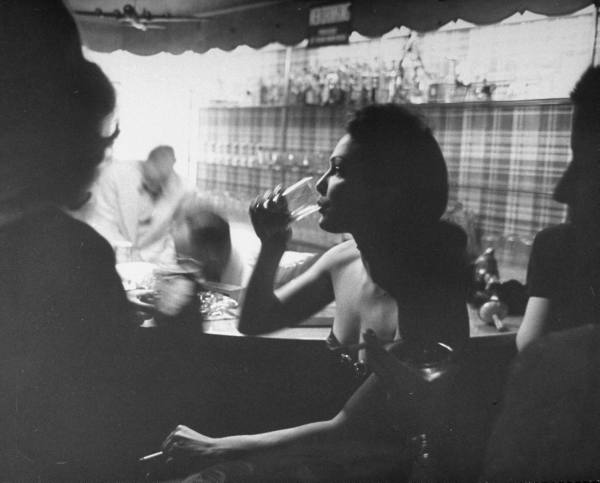 Jess Stearn began his 1956 Sisters of the Night with the famous question Why do women become prostitutes? During his research in New York to find out, Stearn was introduced to different types of women who sell sex. Actually they were women who used different methods to find clients and varying ways to describe what they were doing, but typecasting was and remains popular with unsubtle investigators.
Jess Stearn began his 1956 Sisters of the Night with the famous question Why do women become prostitutes? During his research in New York to find out, Stearn was introduced to different types of women who sell sex. Actually they were women who used different methods to find clients and varying ways to describe what they were doing, but typecasting was and remains popular with unsubtle investigators.
In the 1950s, prostitutes were considered to be separable women: not born bad but becoming bad through not-yet-understood social processes. The type described in the following excerpt is the B-girl, so called because her job was promoting the sale of alcohol to bar clientele: conversing, flirting, flattering drinkers – anything to make them stay at the bar ordering more drinks. A New York City police inspector wonders how such nice-looking girls could be so – bad.
. . . We picked up two girls in the raid. You should have seen them—a blonde and a brunette. They were knockouts. I’ll bet you never saw two better-looking girls in your life–both about twenty-two, the kind any young fellow would go nuts about. I’ve seen a lot in my forty years in the department, but these kids beat anything yet. You just can’t tell a book by the cover any more. They don’t wear make-up, they stare at you with those wide eyes of theirs, and with their skirts and sweaters and saddle shoes they look as if they had just stepped off a college campus. And do you know what? Some of them have. I had a pair in here the other day and I felt like apologizing to them—they looked so sweet and pure. So I watch the way I talk in front of them, and they talk back to me like prostitutes.
The inspector is shocked that women with a clean-cut appearance should be hanging out in certain bars – perhaps in any bars, if they are not accompanied by a male.
Many of these girls, I had learned myself, had drifted into prostitution from the easy promiscuity of Manhattan’s West Side bars. Touring these honkytonk bars night after night, from eleven oclock, when they begin to crowd up, until three or four in the morning, when they close, I had met the B-girls. Occasionally I was accompanied by an H-man (an investigator from the US Public Health Service), whose job it was to track down carriers of venereal disease. The B-girls (B for bar) converge on Manhattan from all over the nation, but many are native New Yorkers. They boast of their ‘amateur standing’ and prefer servicemen, who usually pay them nothing, to civilians, who are prepared to offer liberal rewards.
This is confusing: The inspector says some B-girls got into prostitution because they were (too) promiscuous, but then he says they prefer servicemen who don’t pay them.
All we can do about those B-girls is keep them moving, and then they find another bar someplace else. A lot of them start at sixteen, and if they don’t make the grade by the time they’re twenty-five they’re out in the streets ready to settle for anybody.
And here the idea is that prostitutes either make it or not, which implies there is a hierarchy they are trying to move up in, kind of in contradiction to the story that they are amateurs. Stearn went out to find B-girls and talk to them:
We don’t take money for ourselves, a teenager told me in a bar near Times Square. I’ve helped out sailors more than they’ve helped me. But if they have money and want to leave it for the rent or a new dress, that’s different. pp 24-25
By the 1990s Lawrence Block could have a nice young woman say (in Eight Million Ways to Die):
I mean, I’m not a hooker. I’m a girlfriend. I don’t get paid. They give me money because I’ve got rent to pay and, you know, I’m a poor little Village chick who wants to make it as an actress and she’s never going to.
You don’t hear about B-girls in New York anymore, but the term Bar Girl (along with hostess and beer girl) is ubiquitous in Southeast Asia, with the same ambiguity as to whether the job stops with talking or moves on, when the shift is over, to sex work. The clean-cut qualities of bar girls are often mentioned by reporters, as though there were a fundamental contradiction there – as though, after all, it’s a certain type of female that goes into this business – or ought to.
I finished Sisters of the Night and will report on its conclusions forthwith.
–Laura Agustín, the Naked Anthropologist

The kind of girls who pride themselves on their amateur status and insist they aren’t really prostitutes are now working as sugar babies. As long as the social stigma persists, there will be some who want the benefits the job provides but wish to avoid the stigma even in their own minds.
Yes, that’s a familiar phenomenon. We don’t nowadays imagine they might ‘move up’ into being ‘real prostitutes’ though – at least I have not heard that story.
But also the b-girl story seems to be about people who actually aren’t always doing it for money, so it’s not just that they are avoiding admitting what they do, it’s more about their sex lives, the carousing and sleeping around. Interesting I think for that reason.